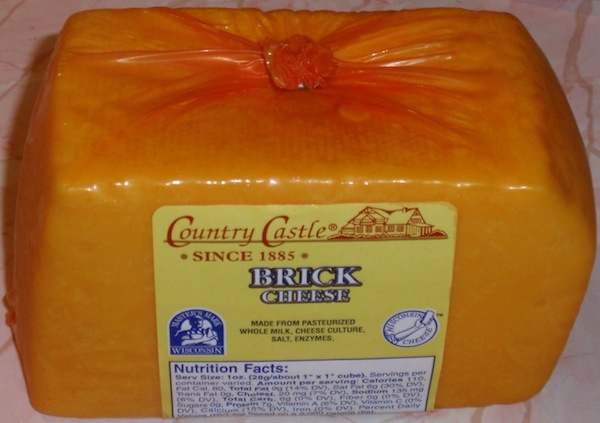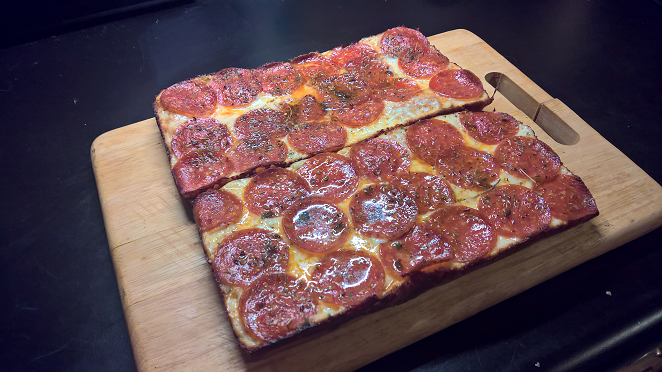|
Brick Cheese
Brick cheese is a cheese from Wisconsin, U.S., made in brick-shaped form. The color ranges from pale yellow to white, and the cheese has a sweet and mild flavor when young, and matures into a strong, ripe cheese with age. It is a medium-soft cheese. Origins Brick cheese was originally produced in Wisconsin beginning in 1877. The cheese-making process was derived from white American Cheddar that is cultured at a slightly higher temperature, which results in a marginally higher fat content and a slightly altered protein structure. The resultant "brick cheese" has a slightly softer texture. Production process Brick cheese is made in the form of a large rectangular or brick shape, but may also be named "brick" because the cheese curds are pressed with clay-fired bricks. Culturing ''Brevibacterium linens'' grows on the surface of brick cheese, making it surface-ripened. ''Brevibacterium linens'' is also the bacterium responsible for the aging of Limburger cheese and many Frenc ... [...More Info...] [...Related Items...] OR: [Wikipedia] [Google] [Baidu] |
Cheese
Cheese is a dairy product produced in wide ranges of flavors, textures, and forms by coagulation of the milk protein casein. It comprises proteins and fat from milk, usually the milk of cows, buffalo, goats, or sheep. During production, milk is usually acidified and the enzymes of either rennet or bacterial enzymes with similar activity are added to cause the casein to coagulate. The solid curds are then separated from the liquid whey and pressed into finished cheese. Some cheeses have aromatic molds on the rind, the outer layer, or throughout. Over a thousand types of cheese exist and are produced in various countries. Their styles, textures and flavors depend on the origin of the milk (including the animal's diet), whether they have been pasteurized, the butterfat content, the bacteria and mold, the processing, and how long they have been aged. Herbs, spices, or wood smoke may be used as flavoring agents. The yellow to red color of many cheeses is produced by adding a ... [...More Info...] [...Related Items...] OR: [Wikipedia] [Google] [Baidu] |
Wisconsin
Wisconsin () is a state in the upper Midwestern United States. Wisconsin is the 25th-largest state by total area and the 20th-most populous. It is bordered by Minnesota to the west, Iowa to the southwest, Illinois to the south, Lake Michigan to the east, Michigan to the northeast, and Lake Superior to the north. The bulk of Wisconsin's population live in areas situated along the shores of Lake Michigan. The largest city, Milwaukee, anchors its largest metropolitan area, followed by Green Bay and Kenosha, the third- and fourth-most-populated Wisconsin cities respectively. The state capital, Madison, is currently the second-most-populated and fastest-growing city in the state. Wisconsin is divided into 72 counties and as of the 2020 census had a population of nearly 5.9 million. Wisconsin's geography is diverse, having been greatly impacted by glaciers during the Ice Age with the exception of the Driftless Area. The Northern Highland and Western Upland along wi ... [...More Info...] [...Related Items...] OR: [Wikipedia] [Google] [Baidu] |
Cheddar Cheese
Cheddar cheese (or simply cheddar) is a natural cheese that is relatively hard, off-white (or orange if colourings such as annatto are added), and sometimes sharp-tasting. Cheddar originates from the English village of Cheddar in Somerset. Cheddar cheese is produced all over the world, and ''cheddar cheese'' has no protected designation of origin either in the United Kingdom or the European Union. In 2007, the protected designation of origin name "West Country Farmhouse Cheddar" was registered in the EU and (after Brexit) the UK, defined as cheddar produced from local milk within Somerset, Dorset, Devon and Cornwall and manufactured using traditional methods. Protected Geographical Indication (PGI) was registered for ''Orkney Scottish Island Cheddar'' in 2013 in the EU, which also applies under UK law. Globally, the style and quality of cheeses labelled as cheddar may vary greatly, with some processed cheeses being packaged as "cheddar". Furthermore, certain cheeses that are sim ... [...More Info...] [...Related Items...] OR: [Wikipedia] [Google] [Baidu] |
Cheese Curds
Cheese curds are moist pieces of curdled milk, eaten either alone or as a snack, or used in prepared dishes. They are consumed throughout the northern United States and Canada. Notably, cheese curds are popular in Quebec, as part of the dish poutine (made of French fries topped with cheese curds and gravy), and in Wisconsin and Minnesota where they are served breaded and deep fried. Curds are sometimes referred to as "squeaky cheese" or ''crottes de fromage'' (literally: "droppings of cheese"). Production Cheese curds are made from fresh pasteurized milk to which cheese culture and rennet are added. After the milk curdles it is then cut into cubes; the result is a mixture of whey and curd. This mixture is then cooked and pressed to release the whey from the curd, creating the final product. Characteristics Their flavour is mild, but can differ in taste depending on the process by which they were made. It has about the same firmness and density as cheese, but with a springy o ... [...More Info...] [...Related Items...] OR: [Wikipedia] [Google] [Baidu] |
Brevibacterium Linens
''Brevibacterium linens'' is a gram-positive, rod-shaped bacterium. It is the type species of the family '' Brevibacteriaceae''. ''Brevibacterium linens'' is ubiquitously present on the human skin, where it causes foot odor. The familiar odor is due to sulfur-containing compounds known as S-methyl thioesters. The same bacterium is also employed to ferment several washed-rind and smear-ripened cheeses such as Munster, Limburger, Tilsit cheese, Port-du-Salut, Raclette, Livarot, Pont l'Eveque, Époisses, Wisconsin Brick, Năsal and Pálpusztai. Its aroma also attracts mosquitoes. The first comprehensive proteomic Proteomics is the large-scale study of proteins. Proteins are vital parts of living organisms, with many functions such as the formation of structural fibers of muscle tissue, enzymatic digestion of food, or synthesis and replication of DNA. In ... reference map of ''B. linens'' was published in 2013. References External linksType strain of ''Brevibacterium ... [...More Info...] [...Related Items...] OR: [Wikipedia] [Google] [Baidu] |
Limburger
Limburger (in southern Dutch contexts Rommedoe, and in Belgium Herve cheese) is a cheese that originated in the Herve area of the historical Duchy of Limburg, which had its capital in Limbourg-sur-Vesdre, now in the French-speaking Belgian province of Liège. The cheese is especially known for its strong smell caused by the bacterium ''Brevibacterium linens''. Herve has been produced since the 15th century. History and geographic origins The Herve name has become the modern European protected name for the cheese, while the Limburger name is used for the same style when made in other regions. Herve cheese, or "Fromage de Herve", is still produced in the territory of the old Duchy of Limburg, in Belgium, where it has been produced since the 15th century. Herve is located near Liège, and the borders separating Belgium from the Netherlands and Germany. The " Land of Herve" is a hilly area between the Vesdre and Meuse rivers. The duchy existed until the French Revolution as a ... [...More Info...] [...Related Items...] OR: [Wikipedia] [Google] [Baidu] |
Standard Of Identity
Standards of identity for food are mandatory requirements that are set by a governing body to determine what a food product must contain to be marketed under a certain name in allowable commerce. Mandatory standards, which differ from voluntary grades and standards applied to agricultural commodities, protect the consumer by ensuring a label accurately reflects what is inside (for example, that mayonnaise is not an imitation spread or that ice cream is not a similar but different frozen dessert). A US trade organization defines the term as follows: A standard of identity sets out what ingredients a product must contain, which ingredients it may contain, and any requirements of manufacturing. For example, "whisky" is defined as "a potable alcoholic distillate obtained from a mash of cereal grain saccharified by diastase of malt or by other enzymes and fermented by the action of yeast". It may contain caramel and flavouring. No other ingredients are allowed. If someone were to produce ... [...More Info...] [...Related Items...] OR: [Wikipedia] [Google] [Baidu] |
Corynebacterium
''Corynebacterium'' () is a genus of Gram-positive bacteria and most are aerobe, aerobic. They are bacillus (shape), bacilli (rod-shaped), and in some phases of life they are, more specifically, club (weapon), club-shaped, which inspired the genus name (''coryneform'' means "club-shaped"). They are widely distributed in nature in the microbiota of animals (including the human microbiota) and are mostly innocuous, most commonly existing in commensalism, commensal relationships with their hosts. Some, such as ''Corynebacterium glutamicum, C. glutamicum'', are commercially useful. Others can cause human disease, including, most notably, diphtheria, which is caused by ''Corynebacterium diphtheriae, C. diphtheriae''. As with various species of amicrobiota (including their relatives in the genera ''Arcanobacterium'' and ''Trueperella''), they usually are not pathogenic, but can occasionally opportunistic infection, opportunistically capitalize on atypical access to tissue (biology), ti ... [...More Info...] [...Related Items...] OR: [Wikipedia] [Google] [Baidu] |
Arthrobacter
''Arthrobacter'' (from the Greek, "jointed small stick”) is a genus of bacteria that is commonly found in soil. All species in this genus are Gram-positive obligate aerobes that are rods during exponential growth and cocci in their stationary phase. ''Arthrobacter'' have a distinctive method of cell division called "snapping division" or reversion in which the outer bacterial cell wall ruptures at a joint. Description ''Arthrobacter'' can be grown on mineral salts pyridone broth, where colonies have a greenish metallic center on incubated at . Under the microscope, ''Arthrobacter'' appear as rods when rapidly dividing, and cocci when in stationary phase. Dividing cells may also appear as chevrons ("V" shapes). Other notable characteristics are that it can use pyridone as its sole carbon source, and that its cocci are resistant to desiccation and starvation. Use in industry ''Arthrobacter'', like other bacterial genera including ''Brevibacterium'', ''Microbacterium'', and '' ... [...More Info...] [...Related Items...] OR: [Wikipedia] [Google] [Baidu] |
Detroit-style Pizza
Detroit-style pizza is a rectangular pizza with a thick crust that is crispy and chewy. It is traditionally topped with Wisconsin brick cheese that goes all the way to the edges and caramelizes against the high-sided heavyweight rectangular pan. This style of pizza was originally baked in rectangular steel trays designed for use as automotive drip pans or to hold small industrial parts in factories. It was developed during the mid-twentieth century in Detroit before spreading to other parts of the United States in the 2010s. The dish is one of Detroit's iconic local foods. History The pizza was developed in 1946 at Buddy's Rendezvous, a former speakeasy owned by Gus and Anna Guerra located at the corner of Six Mile Road and Conant Street in Detroit. Sources disagree whether the original Sicilian-style recipe was based on Anna Guerra's mother's recipe for '' sfincione'' or a recipe from one of the restaurant's employees, a Sicilian woman named Connie Piccinato. According to ... [...More Info...] [...Related Items...] OR: [Wikipedia] [Google] [Baidu] |

.jpg)




